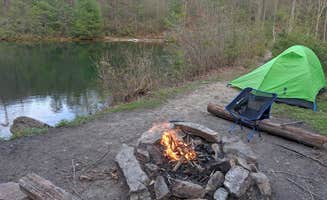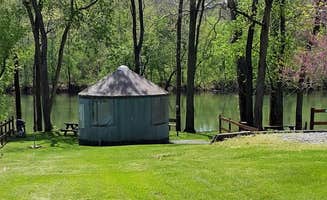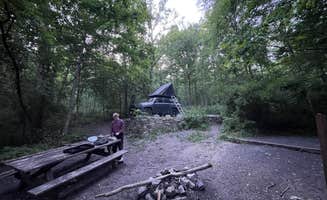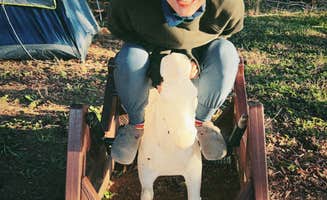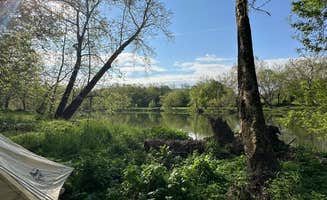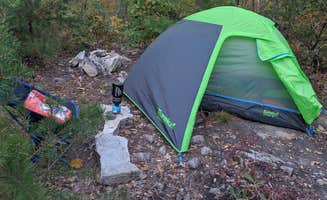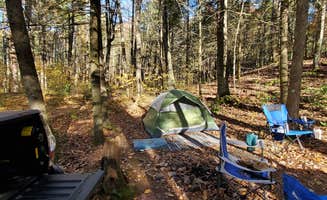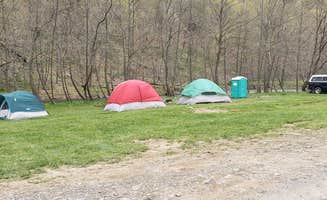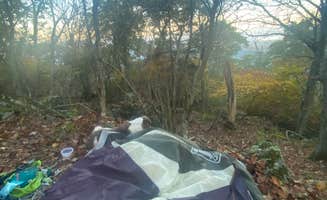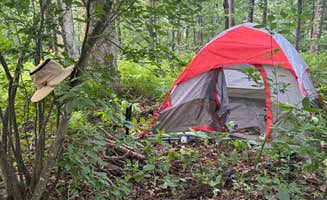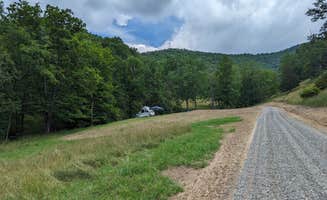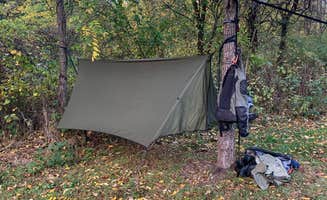Dispersed camping near Basye, Virginia centers around George Washington National Forest, which spans elevations from 1,000 to 4,400 feet with steep mountain terrain. During summer months, temperatures average 75-85°F days with cooler 55-65°F nights, while spring and fall camping can see overnight temperatures drop below freezing. Forest roads leading to most primitive sites require careful navigation, especially after rainfall when even gravel access routes become challenging.
What to do
Hiking with water rewards: At Emerald Pond Primitive Campground, backpackers trek approximately 1.5 miles from the trailhead to find campsites around a spring-fed swimming hole. "We hike this bird knob trail all the time and usually end it by swimming across emerald pond. It's the perfect temperature (in July and august when we've done it). We hang a hammock and let the kids play. There's wild blackberries everywhere," notes one visitor.
Riverside camping: The South Fork Shenandoah River offers direct water access for fishing and swimming. "Our site was amazing! The very last car camping site on the road. We were right on the river, we swam and fished. There were plenty of walk in sites beyond ours," reports a camper. Sites are positioned along the riverbank with varying distances from the parking area.
OHV adventures: For motorized recreation, trails near Little Fort Campground connect to the larger Peters Mill Run/Taskers Gap OHV system. "Great place to camp at if your car can handle it, if you like to offroad this place is for you or if you like hiking this is also for you," shares an enthusiast. Trail difficulty varies from beginner to advanced with rocky terrain requiring high-clearance vehicles.
What campers like
Privacy between sites: At Crisman Hollow Road Camp, the mountainous terrain creates natural separation between camping areas. "A bit dirty but awesome spot near a creek," mentions one visitor. The camp features multiple sites spread along creek beds with established fire rings.
Established tent pads: Wolf Gap Recreation Area provides structured sites with designated flat areas for tents. "Most sites have a paved parking platform and then a second tier for the camp site. All sites are quite large and include picnic tables, fire rings and large tent platforms," explains one camper. These platforms help with tent setup on the otherwise rocky mountain terrain.
Local foraging opportunities: Many campsites in the area offer seasonal berry picking. "There's wild blackberries everywhere. Got our bellies full," mentions a visitor to Emerald Pond. Blackberry season typically peaks in late July through August, with raspberries available slightly earlier in the season.
What you should know
Road conditions vary dramatically: Access to Switzer Lake Dispersed Camping requires navigation of unmaintained forest roads. "Once you turn onto Switzer Lake Rd from U.S. 33 and find the parking area to the lake on your left, be prepared to drive another 2ish miles on a single lane and very bumpy dirt road. Go slow as several sharp corners with huge drops and inexperienced drives coming towards you," cautions a visitor.
Wildlife precautions: Black bears are active in the area, requiring proper food storage. "There are bears here, so lock up your food in the car. We have encountered a bear at or around the campsite 3 times," reports a regular at Switzer Lake. Food should be stored in vehicles or bear-resistant containers, never in tents.
Weekend crowds: The best tent camping near Basye, Virginia fills quickly during peak seasons. "Got the last site at 6PM on the Friday of Memorial Day weekend," notes a camper at Little Fort Campground. Arriving mid-week or before Friday afternoon significantly improves site selection opportunities.
Tips for camping with families
Spring-fed swimming: Emerald Pond offers natural swimming opportunities for families. "It's the perfect temperature (in July and august when we've done it). We hang a hammock and let the kids play," shares a family camper. The pond maintains consistent temperatures and provides a contained swimming area compared to river options.
Site selection for noise control: Choose locations strategically based on potential noise issues. "Don't disregard the warnings about noise like i did, constant speakers all the time until 4am. i think its out of jurisdiction for park rangers so they wont do anything either," warns a South Fork Shenandoah River camper. Sites deeper in the forest or at the ends of camping areas typically experience less disruption.
Accessible waterfront options: Several campgrounds offer varying levels of water access appropriate for different age groups. "We got a nice tour of the mushrooms currently growing at the farm. The camp area sits under a canopy of cedar trees," shares a visitor to Hawk Nest Mushroom Farm, which offers educational opportunities beyond typical camping experiences.
Tips from RVers
Clearance requirements: Most dispersed camping near Basye requires careful vehicle assessment. "Sites are located less than a mile from the paved highway. We found 5 spots just off the road. All were easily accessible by cat or with a small teardrop trailer," notes a visitor to Squirrel Hollow Road Camping.
Smaller trailers recommended: Forest access roads typically accommodate smaller recreational vehicles only. "If you are tent camping or have a camper van the area is fine. Large RV will have a difficult time setting up in the camp area," advises a camper at Hawk Nest Mushroom Farm. Most primitive sites cannot accommodate trailers longer than 20 feet.
Limited turnaround space: Access roads to many sites feature minimal areas for turning vehicles with trailers. "The road was the worst and really not worth the drive in," shares a low-clearance vehicle owner about Switzer Lake. Backing into or out of sites may be necessary on narrow forest roads without established turnaround areas.


